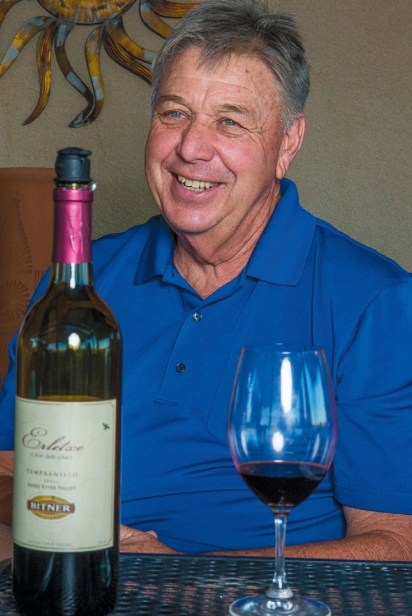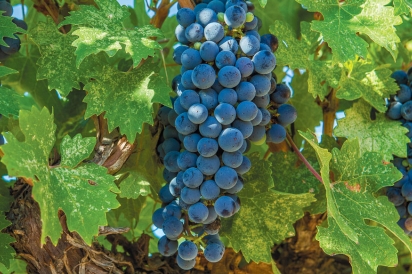The Vineyard is Alive at Bitner
Ron Bitner spent decades traveling the world to teach. Today, people come to him to learn. Bitner welcomes guests on the deck of his wine tasting room at Bitner Vineyards in Canyon County’s Sunnyslope region. His close-cropped gray hair and calm demeanor add a dash of gravitas that balance his eyes, wrinkled by years of frequent smiles.
Although he lives only 80 miles from Midvale where he grew up, Bitner’s journey circled the globe. Since semi-retiring as a world expert on leafcutter bees, Bitner has focused on winemaking. He and his wife, Mary, harvest fruit from vines Ron planted in 1981 as he was launching his entomology career. These days, Bitner teaches environmentally and socially conscious viticulture with a glass of Riesling or Tempranillo in hand.
As he looks out over his 16-acre vineyard, Bitner points to the plants growing between the rows of trellises, adding, “People ask me, ‘Why so weedy?’ Well, it’s good for the soil. It’s not immaculate, but it keeps the soil in place. And many of those plants have little flowers and that’s good for bees.”
A biologist by profession, Bitner developed integrated pest management (IPM) techniques to protect alfalfa seed pollinators. IPM reduces pesticide use by minimizing insect pests, weeds and plant diseases through careful management and use of beneficial insects and cover crops.
Early in his career, Bitner tackled a vexing problem in alfalfa seed production. The flowers are difficult to pollinate and few bees are up to the challenge. Tiny and tenacious leafcutter bees could handle the job and are now the pollinator of choice for Pacific Northwest alfalfa. To protect these valuable workers, Bitner developed IPM guidelines for timing chemical spraying so that it was most effective against pests and least damaging to the bees.
Bitner admits he was nervous when he found aphids attacking another of his experiments: young truffle trees. The roots of the hazelnut and oak trees are inoculated with Périgord black truffle spores, which Bitner hopes will produce the first of these fungi in Idaho. He knew he should refrain from spraying the pests and wait for beneficial insects to arrive. A few days later, lady beetles, commonly known as ladybugs, and lacewings laid eggs that hatched into ravenous young to gobble up the aphids.
His scientific background guides the vineyard’s management, too. The plants between the rows provide habitat for beneficial insects that keep pest insects in check. The Bitners minimize plant diseases by catching problems early and treating by hand.
In 2014, Bitner Vineyards became the first and, so far, only LIVE (Low Input Viticulture and Enology) certified vineyard member in Idaho. The program uses third-party auditors to certify producers in the Pacific Northwest. Members use science-based practices to protect water, soil and pollinators. The program also mandates safe working conditions and fair treatment for workers. Certification takes two years and costs about $2,000 for a small Idaho vineyard. Once certified, the annual cost drops. For Bitner, certification was straightforward, as he was already using many consistent management practices. The Bitners see LIVE as a tangible sign of their commitment to good stewardship. According to LIVE Executive Director Chris Serra, the program is important because it verifies producers’ claims. “Consumers have become much more educated and have a healthy skepticism of eco-claims and the politics of food systems,” he said in an email.
Moya Shatz Dolsby of the Idaho Grape Growers and Wine Producers Commission sees Bitner as a leader in the industry. “More wineries are interested in the LIVE program now that Ron’s been certified,” she said. “He’s in the forefront [of reducing chemical use] and others see it’s possible.”
The view from the Bitners’ deck tumbles down their vineyard to the Snake River and the Owyhee Canyonlands. Cold air drains downhill, away from the tender vines, and the southern aspect allows the sun to warm the plants. This lengthens the growing season, giving the grapes more time to pack in flavor. As a child, Bitner visited cousins in this valley and loved the view. It was Bill Broich, Ste. Chapelle’s first winemaker, who saw that the hillside was perfect for growing Chardonnay grapes. After Broich explained what Chardonnay was, Bitner started planting vines.
As evening shadows climb the poplar trees across the valley, a wine cork with a bee design rests on the table in front of Bitner. The vineyard’s corks all carry an imprint of the bee that took him around the world. He returns the favor by demonstrating how to protect habitat for bees and other creatures with environmentally and socially responsible viticulture.







